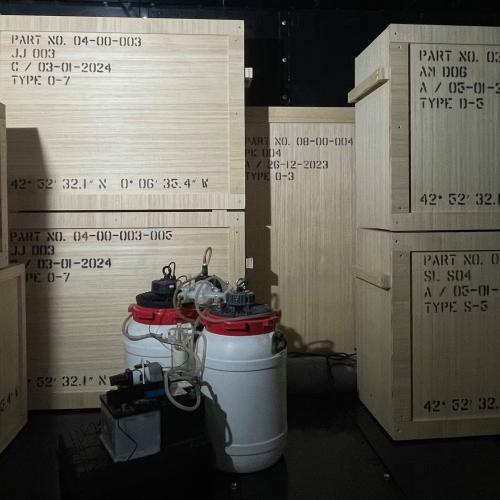Energy Inventions Media Articles
Below are key excerpts of revealing news articles on energy inventions from reliable news media sources. If any link fails to function, a paywall blocks full access, or the article is no longer available, try these digital tools.
For further exploration, delve into our Energy Information Center.
Toyota Prius owners tend to be a proud lot since they drive the fuel-efficient hybrid gas-electric car that's ... one of the hottest-selling vehicles in America. A few, however, felt that good was not good enough. They've made "improvements" even though the modifications voided parts of their warranties. Why? Five words: one hundred miles per gallon. "We took the hybrid car to its logical conclusion," [Felix] Kramer says, by adding more batteries and the ability to recharge by plugging into a regular electrical socket at night. Compared with the Prius' fuel efficiency of 50 mpg, plug-in hybrids use half as much gasoline by running more on cleaner, cheaper, domestic electricity. These trendsetters monkeyed with the car ... to make a point: If they could make a plug-in hybrid, the major car companies could, too. Kramer ... and a cadre of volunteers formed the California Cars Initiative (online at calcars.org). They added inexpensive lead-acid batteries ... giving the car over 100 mpg in local driving and 50 to 80 mpg on the highway. The cost of conversion is about $5,000 for a do-it-yourselfer. Several small companies like EnergyCS ... started doing small numbers of conversions for fleets and government agencies using longer-lasting, more energy-dense lithium-ion batteries. Kramer hired EnergyCS to convert his Prius and reported on a typical day of driving. Compared with driving his Prius before the conversion, he ... spewed out two-thirds less greenhouse gases at a total cost of $1.76 for electricity and gasoline, instead of the $3.17 it would have required on gasoline alone. People want plug-in hybrids but can't get them. Dealers don't sell them yet, and the few conversion services cater to fleets.
Note: For a video and educational package to guide those who want to build a 100 mpg car, see www.eaa-phev.org. For why the car companies with their massive budgets haven't developed cars like this, click here.
Venture capitalists are pouring hundreds of millions of dollars into [Silicon] Valley solar startups pursuing technological breakthroughs to make sun power as cheap as fossil fuel. Three of the largest tech IPOs of 2005 were for solar companies. The world's largest chip-equipment maker will begin producing machines to manufacture solar wafers, laying the groundwork for an industrial infrastructure that should lower the cost of producing solar cells. Solar energy has just the sort of oversize potential that the titans of tech saw in computing: a free and practically inexhaustible power source. California is also committing $3.2 billion to fund a drive to install solar panels on a million rooftops by 2018, and a November ballot initiative ... would tax Big Oil to provide $4 billion in funding for alternative-energy research, programs, and startups. Perhaps no startup has benefited more from the solar gold rush than Nanosolar. The Palo Alto company ... has racked up more than $100 million in funding so far. Nanosolar is pursuing a technology that produces solar cells on a film that's a 100th the thickness of conventional silicon wafers. Its ultimate goal: integrating thin-film cells directly into building materials. A skyscraper's glass windows, for instance, could be embedded with thin-film cells, giving them energy-producing capabilities. Nanosolar plans to build a manufacturing facility next year ... that will eventually produce 430 megawatts' worth of solar cells per year. That would nearly triple the nation's manufacturing capacity and make Nanosolar one of the world's largest solar producers. Thanks to aggressive government subsidies, Germany and Japan are currently the global leaders in solar production.
Note: With all of its talk about energy independence, why isn't the U.S. aggressively supporting research into solar power like Japan and Germany? For reliable, verifiable information which answers this question, click here.
The Plasma Converter ... can consume nearly any type of wastefrom dirty diapers to chemical weaponsby annihilating toxic materials in a process ... called plasma gasification. A 650-volt current passing between two electrodes rips electrons from the air, converting the gas into plasma. The plasma arc is so powerful, it disintegrates trash into its constituent elements by tearing apart molecular bonds. The system is capable of breaking down pretty much anything except nuclear waste. The only by-products are an obsidian-like glass [and] a mixture of primarily hydrogen and carbon monoxide that can be converted into a variety of marketable fuels, including ethanol, natural gas and hydrogen. Perhaps the most amazing part of the process is that its self-sustaining. Once the cycle is under way, the 2,200F syngas is fed into a cooling system, generating steam that drives turbines to produce electricity. About two thirds of the power is siphoned off to run the converter; the rest can be used on-site for heating or electricity, or sold back to the utility grid. Even a blackout would not stop the operation of the facility. New York City is already paying an astronomical $90 a ton to get rid of its trash. According to Startech, a few 2,000-ton-per-day plasma-gasification plants could do it for $36. Sell the syngas and surplus electricity, and youd actually net $15 a ton. But the decision-making bureaucracy can be slow, and it is hamstrung by the politically well-connected waste-disposal industry. Startech isnt the only company using plasma to turn waste into a source of clean energy. A handful of start-upsGeoplasma, Recovered Energy, PyroGenesis, EnviroArc and Plasco Energy, among othershave entered the market in the past decade.
Note: Why hasn't this amazing, proven machine and technology made front page headlines? Read the exciting article at the link above to find how it is already being used. For why you don't know about it, read this excellent article on how such inventions are suppressed.
A Florida man with no medical training has invented a machine that he believes may lead to a cure for cancer. John Kanzius ... wondered if his background in physics and radio could come in handy in treating the disease from which he suffers himself. After 24 rounds of chemotherapy, the former broadcaster decided that he did not want to see others suffer trying to cure the disease. Kanzius said it was watching kids being treated that affected him the most. "Particularly, young children walk in with smiles, and then you'd see them three weeks later and their smiles had disappeared. I said to myself, 'We're in a barbaric type of medicine." Kanzius said his machine basically makes cells act like antennae to pick up a signal and self-destruct. Unlike current cancer treatment, Kanzius' machine does not use radiation, and unlike today's radio-frequency treatments, it's noninvasive. Now, some of the nation's most prominent doctors and scientists are using Kanzius' machines in their research. In January, researchers said they performed a breakthrough at the M. D. Anderson Cancer Center in Houston. "The complete killing of pancreatic cells in laboratory conditions is encouraging," Dr. Steve Curley said. Kanzius explained that his machine uses a solution filled with nanoparticles, which measure no more than one-billionth of a meter. A test subject would be injected with either gold or carbon nanoparticles, which would make their way through the body and attach to the cancerous cells. The test subject would then enter the machine and receive a dose of radio frequency waves, theoretically heating and killing the cancerous cells in moments and leaving nearby cells untouched.
Note: For more on this exciting machine and the man behind it, click here. For other major media articles relating potential cancer cures, click here.
A few small companies and maverick university laboratories, including ... one at U.C.L.A. run by Seth Putterman, a professor of physics, are pursuing quixotic solutions for future energy, trying to tap the power of the Sun hot nuclear fusion in devices that fit on a tabletop. Dr. Puttermans approach is to use sound waves, called sonofusion or bubble fusion, to expand and collapse tiny bubbles, generating ultrahot temperatures. At temperatures hot enough, atoms can literally fuse and release even more energy than when they split in nuclear fission, now used in nuclear power plants and weapons. Furthermore, fusion is clean in that it does not produce long-lived nuclear waste. Dr. Putterman has not achieved fusion in his experiments. He and other scientists form a small but devoted cadre interested in turning small-scale desktop fusion into usable systems. Although success is far away, the principles seem sound. Achieving nuclear fusion, even in a desktop device, is not particularly difficult. But building a fusion reactor that generates more energy than it consumes is far more challenging. Impulse Devices, a small company in the small town of Grass Valley, Calif., is exploring the same sound-driven fusion as Dr. Putterman, pushing forward with venture capital financing. Its president, Ross Tessien, concedes that Impulse is a high-risk investment, but the potential payoffs would be many. You solve the worlds pollution problems, Mr. Tessien said. You eliminate the need for wars. You eliminate scarcity of fuel. And it happens to be a very valuable market. So from a commercial point of view, theres every incentive. From a moral point of view, theres every incentive. And its fun and its exciting work.
Note: To read about a wide array of revolutionary energy technologies, click here.
From a plug-in hybrid car to the sexy electric Tesla Roadster, celebrities wanting to make a green statement on the way to the red carpet of the Oscars will have plenty of environment-friendly rides. Global Green USA has lined up 30 cars to shuttle the likes of Leonardo DiCaprio and Davis Guggenheim, director of the Oscar-nominated documentary on global warming "An Inconvenient Truth," to the star-studded ceremony in Hollywood. The environmental group began the green limousine campaign five years ago at the Oscars to raise awareness among the tens of millions of viewers worldwide about alternative fuel cars, energy independence and solutions to global warming. On a Hollywood parking lot ahead of Wednesday's Global Green USA celebrity party, Steve Schneider showed off his tiny $10,000 ZAP (Zero Air Pollution) cars made in California. One was a mini pick-up and the other a three-wheeler. "It is the first time that common people can be introduced to this type of technology," said Schneider. "We are trying to have mass appeal. This vehicle operates at a cost of a penny a mile." But it is the two-seat, scarlet-colored prototype of the Tesla Roadster, invented and financed in Silicon Valley, that will be the coveted car pulling up to the red carpet. Already 330 celebrities, including George Clooney, have signed up to buy the electric car that goes from 0 to 60 mph (0 to 100 kph) in four seconds. Production will begin later this year and the base price is $92,000, although the company also is working on a sedan that will cost between $50,000 and $65,000.
Note: If the above link fails, click here. Why has the media given so little attention to these breakthrough vehicles? For a possible answer, click here.
Within five years, solar power will be cheap enough to compete with carbon-generated electricity. In a decade, the cost may have fallen so dramatically that solar cells could undercut oil, gas, coal and nuclear power by up to half. Anil Sethi, the chief executive of the Swiss start-up company Flisom, says he looks forward to the day - not so far off - when entire cities in America and Europe generate their heating, lighting and air-conditioning needs from solar films on buildings with enough left over to feed a surplus back into the grid. The secret? A piece of dark polymer foil, as thin a sheet of paper. It is so light it can be stuck to the sides of buildings. It can be mass-produced in cheap rolls like packaging - in any colour. The "tipping point" will arrive when the capital cost of solar power falls below $1 (51p) per watt, roughly the cost of carbon power. The best options today vary from $3 to $4 per watt - down from $100 in the late 1970s. Mr Sethi believes his product will cut the cost to 80 cents per watt within five years, and 50 cents in a decade. "We don't need subsidies, we just need governments to get out of the way and do no harm," he said. Solar use [has] increased dramatically in Japan and above all Germany, where Berlin's green energy law passed in 2004 forces the grid to buy surplus electricity from households at a fat premium. The tipping point in Germany and Japan came once households [understood] that they could undercut their unloved utilities. Credit Lyonnais believes the rest of the world will soon join the stampede. Needless to say, electricity utilities are watching the solar revolution with horror.
Note: Why is this inspiring, important news getting so little press coverage? And why not more solar subsidies? For a possible answer, click here. And for an amazing new energy source not yet reported in the major media which could make even solar energy obsolete, click here.
The planet's most pressing environmental problems ... may seem just too big to be solved with today's technology. But don't despair: A lot of bright minds are working on futuristic projects that promise to make the world greener. It's save-the-world stuff like toxic-waste-eating trees, smart electricity grids, oceangoing robots, and floating environmental sensors. This technology may seem far out - but it will probably be here a lot sooner than you think. 1. Try a solar-powered hydrogen fueling station in your garage. It's about the size of a filing cabinet and runs on electricity generated by standard-issue rooftop solar panels. The first version of the home fueling station is expected to produce enough hydrogen to give your runabout a range of some 100 miles without emitting a molecule of planet-warming greenhouse gas. 2. Environmental sensor networks [provide] real-time data on a variety of phenomena that affect the economy and society - climate change, hurricanes, air and water pollution. 3. Toxin-eating trees ... a technology that uses vegetation to absorb hazardous waste from industrial plants and other polluters. 4. Nuclear waste neutralizer ... a chemical technology called Urex+ that extracts reusable uranium and separates out cesium, allowing four times as much waste to be packed into nuclear burial grounds. 5. Autonomous ocean robots. 6. Sonic water purifier ... a sci-fi solution for an age-old problem that leaves 1.1 billion people without access to clean water: 7. Endangered-species tracker. 8. The interactive, renewable smart power grid ... the electricity grid of the future ... will look more like the Internet - distributed, interactive, open-source - than the dumb, one-way network of today.
Note: For many other exciting discoveries of new energy sources, click here.
What could be greener than a hydrogen car in your driveway? Try a solar-powered hydrogen fueling station in your garage. Australian scientists have developed a prototype of such a device. It's about the size of a filing cabinet and runs on electricity generated by rooftop solar panels. The first version is expected to produce enough hydrogen to give your runabout a range of some 100 miles without emitting a molecule of planet-warming greenhouse gas. Road trips are out of the question, but it's enough juice for running errands or powering fleets of delivery trucks. Tests of the home fueling system began early this year with commercial trials two years off.
Thirty years after it was founded by President Jimmy Carter, the National Renewable Energy Laboratory at the edge of the Rockies here still does not have a cafeteria. The hopes for this neglected lab brightened a bit just over a year ago when President George W. Bush made the first presidential call on the lab since Carter. But one year after the presidential visit, the money flowing into the primary national laboratory for developing renewable fuels is actually less than it was when the Bush Administration took office. "Our budget is nothing compared to the price of a B-2 bomber or an aircraft carrier," said Rob Farrington, manager of advanced vehicle systems at the lab. The problem is that, despite a lot of promises, no one so far has wanted to pay the extra costs to make wind and solar more than a trivial energy source. Most of the money and attention is still focused on the dirty, but cheaper energy standbys: offshore oil, oil sands and coal. Companies can still deduct purchases of sport utility vehicles and utility bills. Meanwhile, fuel efficiency standards for automobiles have changed only slightly over the decades. Renewable energy today supplies only 6 percent of America's energy needs. Under current policies [renewables] would supply 7 percent of U.S. energy supplies by 2030 while coal would increase over the same period from 23 percent to 26 percent. While top energy companies are ... beginning to invest significant amounts of money in wind, solar and biomass, those investments pale in comparison with the resources they are pouring into making synthetic fuels out of oil sands, which emit significantly more carbon than conventional oil.
Note: With all the talk about oil dependence and energy crisis, why wouldn't the government and industry want to put serious money into development of new energy sources? For a startlingly clear answer, click here.
Turning corn into fuel is all the rage these days as America attempts to reduce its oil dependency. But a team of Metro Detroit researchers has identified a potentially cheaper and more Earth-friendly fuel source: peat, that half-rotted vegetation that covers a considerable chunk of Michigan. The scientists, from University of Detroit Mercy and Wayne State University, are working to develop what they call "pethanol" to run small, fuel-cell-powered vehicles such as golf carts and riding mowers. Because peat forms naturally and requires no fertilization, it's a benefit over corn, the researchers say. "Corn's biggest problem is that you only get one crop a year," said John Shewchun, an adjunct chemistry and engineering professor at Wayne State. "Peat is dirt cheap (to harvest), and with it you've got something that is easily replenished." In lab tests, the pethanol has also powered a fuel cell without the use of hydrogen, which eliminates the need for hydrogen storage tanks in fuel-cell vehicles. Benvenuto, principal investigator on the project, said if peat works as a fuel, the researchers will look at duplicating its success with other hearty native Michigan plants. He said the answer is likely not one plant, but a variety of sources. "None of the three of us think this will solve America's energy dependence," Benvenuto said. "But it will help."
Chuck Larue may be the man who drastically cuts your electricity bill. For fourteen years, Chuck and his partner have quietly been inventing a little micro controller called the "Plug Power Saver." He claims it works on all electric motors from your air conditioner to refrigerators, washing machines to whole house fans. He rigged a one-third horsepower motor to show us the savings. Without the controller, It's drawing 171 to 180 watts." Plug in the Power Saver and, It's trying to find the most optimum levels of power consumption. It actually has a microprocessor in here." After a few seconds, the motor is running strong but using half the electricity. And if you know anything about electricity, you know this motor running normally should be warm to the touch, it isnt. That seems to show no extra electricity is being lost as heat. John Lander: This looks already to sell. Chuck Larue: Yeah it is, it's ready to go. John Lander: How much? Chuck Larue: $49.95. So you'd pay for the Power Saver in under a year. Chuck says he has 10,000 of these devices headed here from a manufacturing plant in Korea. Now all he has to do is find a retailer willing to sell it. Chuck says he has tried to interest the Governor and the utilities commission to sponsor his invention, but no one has called him back.
Israel is using nanotechnology to try to create a robot no bigger than a hornet that would be able to chase, photograph and kill its targets, an Israeli newspaper reported on Friday. The flying robot, nicknamed the "bionic hornet," would be able to navigate its way down narrow alleyways to target otherwise unreachable enemies such as rocket launchers. It is one of several weapons being developed by scientists to combat militants. Others include super gloves that would give the user the strength of a "bionic man" and miniature sensors to detect suicide bombers. Deputy Prime Minister Shimon Peres [said] "The war in Lebanon proved that we need smaller weaponry. It's illogical to send a plane worth $100 million against a suicidal terrorist. So we are building futuristic weapons." Prototypes for the new weapons are expected within three years, he said.
The tangle of cables and plugs needed to recharge today's electronic gadgets could soon be a thing of the past. US researchers have outlined a relatively simple system that could deliver power to devices such as laptop computers or MP3 players without wires. The concept exploits century-old physics and could work over distances of many metres. Although the team has not built and tested a system, computer models and mathematics suggest it will work. "Resonance" [is] a phenomenon that causes an object to vibrate when energy of a certain frequency is applied. "When you have two resonant objects of the same frequency they tend to couple very strongly," Professor Soljacic [explained]. Resonance can be seen in musical instruments. "When you play a tune on one, then another instrument with the same acoustic resonance will pick up that tune, it will visibly vibrate," he said. Instead of using acoustic vibrations, the team's system exploits the resonance of electromagnetic waves. Electromagnetic radiation includes radio waves, infrared and X-rays. The team from MIT is not the first group to suggest wireless energy transfer. Nineteenth-century physicist and engineer Nikola Tesla experimented with long-range wireless energy transfer, but his most ambitious attempt - the 29m [it was actually 187 feet] high aerial known as Wardenclyffe Tower, in New York - failed when he ran out of money. A UK company called Splashpower has also designed wireless recharging pads onto which gadget lovers can directly place their phones and MP3 players to recharge them.
Note: What the article fails to mention is that Tesla's experiments previous to the 1903 Wardenclyffe tower were quite successful, so much so that J.P. Morgan was willing to pour huge amounts into the tower. When he learned, however, that Tesla's intention was to make energy available free to the public, he pulled the plug on the project and many of Tesla's amazing inventions were buried and erased from the history books. For verification, click here and here. For lots more on suppressed energy inventions, click here.
In the quest for oil-free power, a handful of small companies are staking claims on the boundless energy of the rising and ebbing sea. The technology that would draw energy from ocean tides...is largely untested, but several newly-minted companies are reserving tracts of water from Alaska's Cook Inlet to Manhattan's East River in the belief that such sites could become profitable sources of electricity. The site that is furthest along in testing lies in New York's East River, between Manhattan and Queens, where Verdant Power plans to install two underwater turbines this month. If all goes well, New York-based Verdant could have up to 300 turbines in the river by 2008. The turbines would produce as much as 10 megawatts of power, or enough electricity for 8,000 homes. With 12,380 miles of coastline, the U.S. may seem like a wide-open frontier for the fledgling industry, but experts say interest will focus on only a few. Government and the private sector in Europe, Canada and Asia have moved faster than their U.S. counterparts to support tidal energy research. As of June 2006, there were small facilities in Russia, Nova Scotia and China, as well as a 30-year-old plant in France, according to a report by EPRI. Tidal power proponents liken the technology to little wind turbines on steroids. Water's greater density means fewer and smaller turbines are needed to produce the same amount of electricity as wind turbines. Wave energy technology is less advanced than tidal and will need more government subsidies...however, the number of good wave sites far exceeds that of tidal. But a few companies are working aggressively to usher wave power into the energy industry.
Note: To understand why the U.S. is moving slowly, see http://www.WantToKnow.info/newenergysources.
At their factory in southern France, father-and-son team Guy and Cyril Negre insist air power is no joke. Plain old air compressed in the tank, they say, cheap and non-polluting. Sound too good to be true? Says Cyril, It's a real car. The other thing is it's a very zero emission car. You won't pollute, there won't be emission. You have a very economical car. A car, says the Negres, that will cost just $2 for every 120 miles. The Negres have a long love affair with cars. Guy designed a Formula One race car engine. Cyril worked at Bugati. The technology for their car, they say, is relatively simple and safe. When you compress the air...inside of the tank, this is like compressing a spring, and then the tank gives you back the energy of the air when it expands, says Cyril. Compressed air in a carbon-fiber tank, something like scuba divers use, drives the pistons and turns the crankshaft. There is no combustion and no gasoline. That's why there's no pollution. You fill it up at an air compressor. It may sound far-fetched, but at his labs on the campus of UCLA, professor Su-Chin Chow is also exploring the power of air. The Negres say after years of delays...they have solved their technical problems. Another year, they say, and they'll be ready for large scale production, with a top speed of 55 miles-an-hour.
The U.S. Department of Energy (DOE) is quitting the hydropower and geothermal power research business -- if Congress will let it. Declaring them "mature technologies" that need no further funding, the Bush administration in its FY 2007 budget request eliminates hydropower and geothermal research. "What we do well is research and funding of new, novel technologies," says Craig Stevens, chief spokesman for the DOE. "I'm just astonished the department would zero out these very small existing budgets for geothermal and hydro," says V. John White, executive director of the Center for Energy Efficiency and Renewable Technologies. "These are very important resources for our energy future that could replace the need for a lot of coal-fired power plants." Indeed, the costs of lost opportunities from dropping such research could be enormous in the long run. Geothermal holds vast potential -- at least 30,000 megawatts of identified resources developable by 2050. Meanwhile, the more than 5,400 potential "small hydro" power projects could produce about 20,000 megawatts of power, a DOE study in January found. And most would require no new dams at all, shunting a portion of a small river's flow to one side to make electricity. Others would add turbines to dams that don't have them yet. Together, high-tech hydropower and geothermal resources could contribute at least enough power to replace more than 100 medium-size coal-fired power plants with emissions-free electricity.
These dynamic and personable businessmen from Dublin insist that they have found a way of producing free, clean and limitless energy out of thin air. So, as they prepare to demonstrate this wonder of science to me...I feel all the excitement of Christmas Day. There is a test rig with wheels and cogs and four magnets meticulously aligned so as to create the maximum tension between their fields and one other magnet fixed to a point opposite. A motor rotates the wheel bearing the magnets and a computer takes 28,000 measurements a second. And when it is all over, the computer tells us that almost three times the amount of energy has come out of the system as went in. In fact, this piece of equipment is 285% efficient. "We couldn't believe it at first, either," says McCarthy, chief executive of the company. "We wanted to improve the performance of the wind generators...so we experimented with certain generator configurations and then one day one of our guys...came in and said: 'We have a problem. We appear to be getting out more than we're putting in.'" That was three years ago. Since then, McCarthy says, the company has spent 2.7m developing the technology. Until their claims have been assessed by the jury, McCarthy says they won't be accepting any investor offers. So if this is a hoax, it would appear not to be a money-making scheme. The Economist ad alone cost 75,000. "We expected stick, and we're getting it already. We've had a lot of abusive emails and telephone calls -people telling us to watch our backs"
Note: To understand how this is possible, see http://www.WantToKnow.info/newenergysources
A man who claims to have developed a free energy technology which could power everything from mobile phones to cars has received more than 400 applications from scientists to test it. Sean McCarthy says that no one was more sceptical than he when Steorn, his small hi-tech firm in Dublin, hit upon a way of generating clean, free and constant energy from the interaction of magnetic fields. 'It wasn't so much a Eureka moment as a get-back-in-there-and-check-your-instruments moment, although in far more colourful language,' said McCarthy. But when he attempted to share his findings, he says, scientists either put the phone down on him or refused to endorse him publicly in case they damaged their academic reputations. So last week he took out a full-page advert in the Economist magazine, challenging the scientific community to examine his technology. McCarthy claims it provides five times the amount of energy a mobile phone battery generates for the same size, and does not have to be recharged. Within 36 hours of his advert appearing he had been contacted by 420 scientists in Europe, America and Australia, and a further 4,606 people had registered to receive the results.
Steorn has now posted a slick, five-minute video that features interviews with company CEO Sean McCarthy as well as the company's marketing director. For more background, see our earlier discussion. The video's slick, and not too heavy on scientific detail. But it's worth checking out. It does begin to explain the company's motivations for choosing to issue a challenge in the Economist. McCarthy: "The first roadblock is science. With the academic community, it might take five to seven years before being able to get to a consensus position. As a business, that makes absolutely no sense." The video explains that a "quiet" campaign was plan A. The direct marketing approach currently being taken is Plan B. McCarthy: "The claim does rail against so much thinking from ordinary people. We have to fight public opinion, we have to fight the scientific community and we have to fight the energy industry. We couldn't pick a worse battleground."
Note: For lots more on the many who have developed similar discoveries and how they have been either bought out or shut down, click here.
Important Note: Explore our full index to key excerpts of revealing major media news articles on several dozen engaging topics. And don't miss amazing excerpts from 20 of the most revealing news articles ever published.











































































